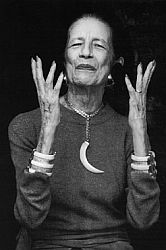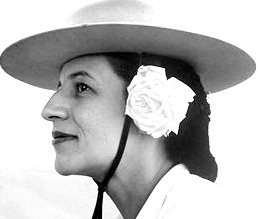Welcome to 2011!
We now live in the future.
 I spent the last days of 2010 reading D.V. by Diana Vreeland (well, dictated by Diana Vreeland and recorded by George Plimpton and Christopher Hemphill). Diana was a fashion editor at Harper’s Bazaar and then went on to be Editor in Chief of Vogue. The book portends to be an autobiography but really it is a collection of thoughts on a wide variety of subjects which manages to morph by the end into a very distinct worldview.
I spent the last days of 2010 reading D.V. by Diana Vreeland (well, dictated by Diana Vreeland and recorded by George Plimpton and Christopher Hemphill). Diana was a fashion editor at Harper’s Bazaar and then went on to be Editor in Chief of Vogue. The book portends to be an autobiography but really it is a collection of thoughts on a wide variety of subjects which manages to morph by the end into a very distinct worldview.
It’s not a worldview many of us subscribe to today, which is too bad. In some ways she seems like a silly, rich woman but, the more you read about her, the more you start to catch her wave. Here are some Vreelandisms:
I loathe nostalgia.
I’m big on larders.
Pink is the navy blue of India.
I was simply mad about Queen Mary.
How I miss fringe! Where is fringe today?
Unshined shoes are the end of civilization.
Asparagus should be sexy and almost liquid.
I’m terrible on facts. But I always have an idea. If you have an idea you’re well ahead.
Never fear being vulgar. Just boring.
As you can tell, she came from another time, if not another dimension. But she was never boring. As it happens, I have a couple of more serious Vreelandisms posted over my desk:
“I’m looking for the suggestion of something I’ve never seen before.”
“The energy of imagination, deliberation, and invention, which fall into a natural rhythm totally one’s own, maintained by innate discipline and a keen sense of pleasure – these are the ingredients of style. And all who have it share one thing: originality.”
Diana Vreeland was born in 1903 in Paris to an American mother and an English father. Well, “raised” is a strong word. She was… supported? Because she and her younger sister were actually raised by nannies and nurses, as many rich kids were then and still are today. Her mother was young, beautiful and sexually promiscuous. Her father was tall, very British and a stockbroker. Among his favorite sayings, used most notably when his wife became the center of a divorce scandal involving another man, was “Worse things happen at sea.” If that’s not stoicism, I don’t know what is.
When she was still a child, the family moved to New York and this is where finished growing up. She didn’t go to school. She talks about attending the Brearley School and being asked to leave after three months. The answer to the school conundrum was to enroll in dancing school. Her whole life, Diana loved to dance.
She didn’t get along with her mother, who seems like a perfect old-school bitch who did what she wanted when she wanted. Diana was not pretty (she makes a point of saying that she didn’t look like her mother at all) but her younger sister was. When she was still a child, Diana’s mother said to her, “It’s too bad that you have such a beautiful sister and that you are so extremely ugly and so terribly jealous of her.”
Ouch. Almost better to take an actual slap to the face.
Diana had her coming out party in 1923 but was denied membership in The Colony Club, a frou-frou ladies club her grandmother had helped to found, because rumor had it that Diana was “fast.” This was apparently OK with Diana because all she wanted to do was go dancing in the nightclubs downtown, which sounds more fun than sitting around with stuffy ladies. Interestingly enough, her mother was upset that she didn’t get into the club, despite the fact that she set no kind of example, having affairs with any number of men and flirting with Diana’s boyfriends.
When Diana did marry, at 18, the church was nearly empty due to the fact that it coincided with the aforementioned divorce scandal her mother was embroiled in. Diana speculates that perhaps the invitations were thrown out by mistake and then admits that the newspapers also didn’t announce her wedding because of the scandal. It sounds as if high society had turned its back on her family.
Diana was happy to marry Reed Vreeland, who started out as a banker. She said, “I never felt comfortable about my looks until I married Reed.” They moved to Albany so that could continue his work in banking and then eventually they moved to London. Of these years she says she was happy, although she also said, “I only moved where he wanted to go. I had nothing to do – but nothing. I never had an idea,” and that she spent the first 12 years of her marriage reading books. Oh, and she gave birth to two sons, who were promptly raised by nannies and nurses. She reserved Wednesday afternoons for them, which was the nanny’s day off.
Diana and her family moved back to New York (before World War II) and she was “asked” to work by the editor of Harper’s Bazaar, Carmel Snow, who had admired Diana and her style at various parties around town. Why Diana decided to go to work remains murky in her autobiography but she does make an allusion to “going through money like water,” after moving back to the U.S. and the fact that Reed actually lived in Montreal during the war – for seven years. For seven years they lived apart and all she says about it is, “It was a very vivid period of my life.”
Perhaps her marriage, like her mother’s, was the old-fashioned kind guided by the “Don’t Ask, Don’t Tell,” principle. She says of Reed, “Reed and I never discussed business. It would have bored him to death.” In any case, they remained married for 46 years, until Reed died of cancer in 1966, only six weeks after being diagnosed.
His doctor asked Diana if she and Reed had discussed his diagnosis and she said, “Of course not! Why would he and I discuss cancer?”
When she goes to see Reed at the hospital after he has received the news, he is quiet for a long time and then he says, “Well, they’ve told you and they’ve told me, so now it’s on the table. Nothing to be done about it.” And that was it.
After she left Harper’s (where she says she made $18,000 a year for 28 years!) Vreeland served as the chief editor of Vogue from 1963 to 1977. She often spent mornings locked away working in her home bathroom. She also liked to take cat naps there.
She believed in the restorative powers of tea, witch hazel and sleep. She knew everyone, including CoCo Chanel, Marion Davies (who she describes as having a champagne chin), Bunny Mellon, Wallis Simpson, Jack Nicholson, Isak Dinesen, Elsie Mendl, Cole Porter, etc.
After Vogue fired her in 1977, she organized exhibits for the Costume Institute at the Metropolitan Museum of Art. She died in 1989 at the age of 86.
Vreeland may be best remembered for her saucy wit, exemplified in her column, “Why Don’t You…” which ran in Harper’s Bazaar. It had a way of getting people riled up with it’s wacky and wild suggestions. Vreeland was following her own advice of never being boring when she said things like:
Why Don’t You…
Turn your old ermine coat in a bathrobe?
Wash your blond child’s hair in dead champagne, as they do in France?
Turn your child into an Infanta for a fancy-dress party?
So, in the spirit of Vreeland and the new year, I leave you with some “Why Don’t You’s” of my own:
Why Don’t You…
Hire an intern to manage your day-to-day affairs?
Enjoy a midday cheese and fruit plate at the office?
Dare to be happy? (borrowed from Gertrude Stein)
Wear a hot pink flower in your hair in the middle of January?
Embrace sequins?
Learn to speak Portuguese?
Throw your beret in the air the next time it snows?

For more great photos and quotes from D.V., check out this post on Fashion’s Most Wanted.
Want to read some D.V. for yourself? D.V. seems to be out-of-print but is available in used paperback and another book by Diana, Allure, is now back in print.
One thought on “Here’s To You, D.V.”
Comments are closed.